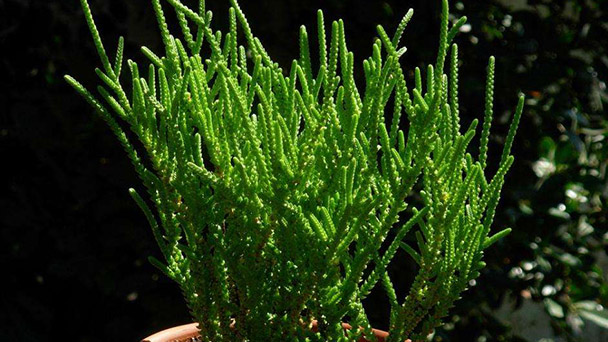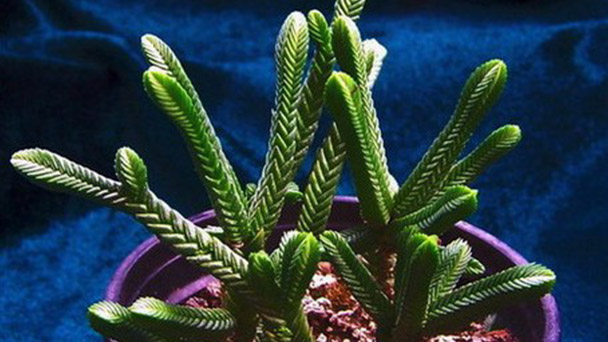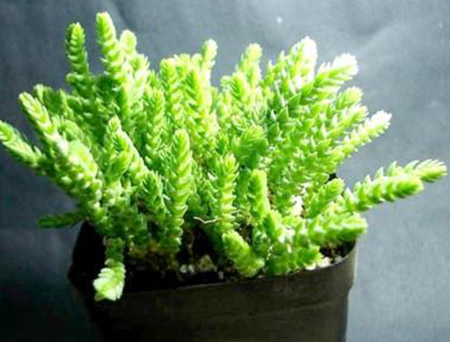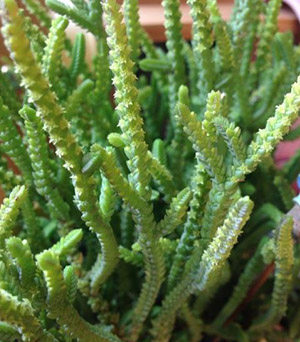How to grow Crassula lycopodioides
Written by Maggie
Nov 12 2020

Crassula lycopodioides, its branches and leaves are always upwards, and its cross section is triangular. Its leaves are closely adjacent one by one, like dragon scales, with verdant and tender colors. It is called Crassula lycopodioides.
Crassula lycopodioides picture

Morphological characteristics of Crassula lycopodioides
Crassula lycopodioides, Crassulaceae Cyanosaurus, dicotyledonous plant, perennial herb. Succulent subshrubs, 30 cm tall, with thin stems that are easy to branch, and stems and branches are usually vertically upward. The leaves are scaly triangular. Native to Namibia.
Branches
Crassula lycopodioides is a succulent subshrub with a height of 30 cm. The stems are thin and easy to branch. The stems and branches are usually vertically upward.
Leaf
The leaf scales of crassula lycopodioides are generally triangular, arranged in 4 ridges on the stem and branches, and are so tight that people mistakenly believe that there are only 4 ridge stems and branches without leaves, and the leaves are scattered when the light is insufficient.
Flower
The flowers of Crassula lycopodioides are small and grow in the leaf axils. Yellow white poplar is a common succulent plant, which is easy to cultivate and reproduce. However, the commercially available varieties of Qingsuolong are not pure. One of the varieties, Ruolu, is also called Qingsuolong in many places. If the green branches are vertical and upward, they are also horizontally creeping, and the leaves are arranged in a random manner, sometimes with four ridges and sometimes not with four ridges.
According to the opinions of many foreign experts, the scientific name of Crassula lycopodioides was changed to C.muscosa. But it is not completely unified, and the old scientific name is used here temporarily.

Ecological habits of Crassula lycopodioides
Crassula lycopodioides likes a warm, dry and sunny environment. Afraid of low temperature and frost and snow. Resistant to half shade. The soil requirements are not strict, and peat soil and coarse sand are better. The temperature in winter is not lower than 5℃.
The propagation and cultivation of Crassula lycopodioides
Breed
Crassula lycopodioides is mainly reproduced by cuttings, which can be carried out throughout the year. It takes root in spring and autumn and has a high survival rate. Select neatly arranged branches with scaly leaves, cut them into 12-15 cm long, and insert them into the mouth of the sand basin. After insertion, they will take about 20-25 days to take root. When the roots are 2-3 cm long, they can be potted.
Cultivation
The potting soil for Crassula lycopodioides should be well-drained, loose and fertile sandy loam. Water 2-3 times a week during the growth period. Water 1-2 times a week during the rainy season and high temperature season. Fertilize once every 2 months. When the plant grows too high, it needs to be topped and lowered, and the branches with too many branches or too oblique and dense branches should be cut thinly. When setting up outdoors, avoid heavy rain, otherwise the roots will be damaged and the branches will turn yellow and rot. Every 2-3 years, the plants need to be renewed by cutting.
Daily maintenance of Crassula lycopodioides
Potted Crassula lycopodioides usually do not need to be watered too much, just keep the pot soil slightly moist, and try to pour it in the soil when watering, the leaves will be affected by water. Don't pour it on the flower core, it will rot. Apply the decomposed thin liquid fertilizer or compound fertilizer once a month. In winter, put it in a sunny place indoors, and continue to water and fertilize above 10°C to make the juvenile grow normally. If you use watering sparingly, keep the pot soil moderately dry, and let the youngsters tolerate low temperatures of 3 to 5°C. The pot should be changed once every 2 to 3 years, which can be carried out in spring or autumn. The pot soil is required to be loose, fertile, and have good drainage. Mixed soil of 1 part each of leaf-humid soil and garden soil, and 2 parts of coarse sand or frog stone can be used. And mixed with a small amount of bone meal, plant ash as base fertilizer.

Disease control of Crassula lycopodioides
Crassula lycopodioides is mainly caused by brown spot and leaf spot. Spray Bordeaux mixture (1:1:100) once a month.
Crassula lycopodioides pests are harmful by red spiders and scale insects. It can be sprayed with 50 {bf} pine EC 1000 times.
Garden uses of Crassula lycopodioides
Crassula lycopodioides is a fine-leaf variety of succulent plants: clusters of stems and leaves, green in all seasons, shaped like stone pine. Light green flowers bloom in autumn, elegant and lovely. It is suitable for potted plant viewing, and it is more attractive to embellish coffee tables, desks and bookcases.
Latest Updated
- Benefits of Bugleweed - 7 Science-backed Health Benefits
- Bugleweed Dangers & Side Effects - Is It Poisonous?
- How to Plant Evergreen Trees - What You Should Know
- When to Plant Evergreens - Grow Guide for Evergreen Trees
- 12 Wonderful Evergreen Shrubs for Your Garden
- 12 Popular Evergreen Plants with Pictures for Beginners
- When And How To Prune A Lilac Bush Like a Pro
- How to Grow & Care for Lilac Vine (Hardenbergia Violacea)
- Japanese Lilac Tree (Syringa Reticulata) Care & Propagation Guide
- Shumard Oak Pros and Cons - What to Know
Popular Articles
- Winter maintenance of Antirrhinum Majus
- How to Grow Terminalia Mantaly Tree
- How to Grow and Care for Crossostephium Chinense
- How to grow Antirrhinum Majus in spring
- Peristeria Elata (Dove Orchid) Profile: Info & Care Guide
- Underwatered Snake Plant (Sansevieria Trifasciata) - Signs And How To Fix
- How to Care for Brazilian Jasmine Plant (Mandevilla Sanderi)
- How to Grow & Care for Graptopetalum Purple Delight in Summer
- Rosa Chinensis (China Rose): Plant Growing & Care Tips
- How to Care for Baby Sun Rose (Aptenia Cordifolia)